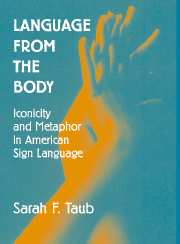Book contents
- Frontmatter
- Contents
- List of Figures
- Acknowledgments
- 1 A Glimpse of the Material
- 2 Motivation and Linguistic Theory
- 3 Iconicity Defined and Demonstrated
- 4 The Analogue-Building Model of Linguistic Iconicity
- 5 Survey of Iconicity in Signed and Spoken Languages
- 6 Metaphor in American Sign Language: The Double Mapping
- 7 Many Metaphors in a Single Sign
- 8 The Vertical Scale as Source Domain
- 9 Verb Agreement Paths in American Sign Language
- 10 Complex Superposition of Metaphors in an American Sign Language Poem
- 11 The Future of Signed-Language Research
- Appendix 1 Glossing Conventions
- Appendix 2 Translation of “The Treasure”
- References
- Index
3 - Iconicity Defined and Demonstrated
Published online by Cambridge University Press: 16 October 2009
- Frontmatter
- Contents
- List of Figures
- Acknowledgments
- 1 A Glimpse of the Material
- 2 Motivation and Linguistic Theory
- 3 Iconicity Defined and Demonstrated
- 4 The Analogue-Building Model of Linguistic Iconicity
- 5 Survey of Iconicity in Signed and Spoken Languages
- 6 Metaphor in American Sign Language: The Double Mapping
- 7 Many Metaphors in a Single Sign
- 8 The Vertical Scale as Source Domain
- 9 Verb Agreement Paths in American Sign Language
- 10 Complex Superposition of Metaphors in an American Sign Language Poem
- 11 The Future of Signed-Language Research
- Appendix 1 Glossing Conventions
- Appendix 2 Translation of “The Treasure”
- References
- Index
Summary
ICONICITY AND RESEMBLANCE DEFINED
In this chapter, we begin to look closely at iconicity in language: After establishing a definition of iconicity, we examine examples of iconicity in signed and spoken languages in some detail. Once we have gotten a sense of how iconicity manifests itself in language, we briefly review how linguists have treated iconicity. This discussion focuses on iconicity in signed languages and traces a development of sophistication in sign linguists' theories. The next chapter presents a cognitive model of iconicity in signed and spoken languages, and the following chapter (Chapter Five) gives a survey of types of iconic items in both modalities.
Let us start by considering the results of Pizzuto, Boyes-Braem, and Volterra (1996). This study tested the ability of naïve subjects to guess the meanings of signs from Italian Sign Language (LIS). Because one simple definition of iconicity is “form-meaning resemblance,” we might expect that we could use “guessability” (also called transparency) as a measure of a sign's iconicity. Yet Pizzuto et al. found strong culture-based variation: Some signs' meanings were easily guessed by non-Italian nonsigners; some were more transparent to non-Italian Deaf signers; and yet others were more easy for Italian nonsigners to guess. That is, some transparency seemed to be universal, some seemed linked to the experience of Deafness and signing, and some seemed to have a basis in Italian culture.
In interpreting these results, we can see the need for a definition of iconicity that takes culture and conceptualization into account.
- Type
- Chapter
- Information
- Language from the BodyIconicity and Metaphor in American Sign Language, pp. 19 - 42Publisher: Cambridge University PressPrint publication year: 2001



